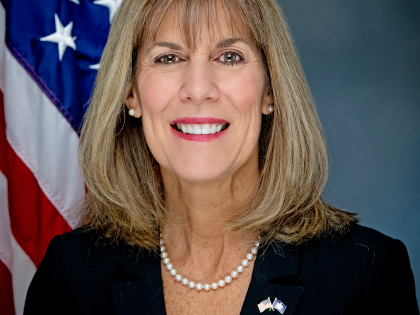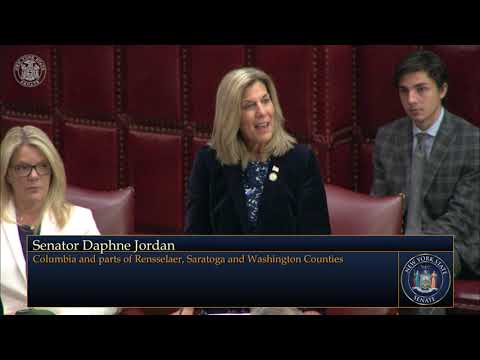
Senator: Study split of New York state

With deepening political, economic and cultural divisions in the two regions, Sen. Daphne Jordan believes it is time for a thorough study of whether upstate should split off from New York City, Long Island and the surrounding suburbs and become the 51st state.
Jordan, R-Halfmoon, has introduced a bill to create a working group that would study the short-term and long-term economic consequences and opportunities of dividing the state in two. Her bill defines downstate as the five boroughs of New York City and Westchester, Nassau, Suffolk and Rockland counties.
Jordan cited the issues of gun control, tuition assistance for children of undocumented immigrants, infrastructure and school funding, taxes and spending and even the choice for governor in a press release.
“I call this a tale of two states. And it really has been that, a tale — let’s find out some of the facts,” she said in a follow-up interview.
Jordan said she has seen differing figures that downstate provides 45 percent of the state’s revenues and another figure that says 70 percent of revenues come from downstate.
A Politifact story last year offered a detailed answer to the question.
About 40 percent of the state's tax revenue came from New York City residents alone.
The total for those in New York City and three downstate counties — Westchester, Nassau and Suffolk — equaled 66 percent of the state total.
Another $7.8 billion came from non-residents who commuted into New York state for work. Most of those filers worked in New York City. Adding the revenue from non-residents to that of New York City, Westchester, and Long Island filers, the share increases to 82 percent of the state total.
But Jordan said she has not seen much about the cost side of things.
“Many people upstate believe that social services costs are New York City-driven and when you add it up, it could offset personal income tax revenues. I don’t know if that’s true,” she said.
Jordan said there could be economic opportunities upstate.
“With a government that’s more business-friendly and not ranked 49th, with less taxes and less regulation, perhaps there would be an economic boom,” she said.
A May 2004 study by the Public Policy Institute found that the number of private sector jobs for the upstate regions grew by 1.5 percent from 1990 to 2003, compared with 2.7 percent for the state as a whole.
National private sector jobs increased by 19 percent during that same time period. Total job growth went up by about 14 percent upstate compared with 9 percent for New York City when public sector jobs are factored into the equation.
A report by the Public Policy Institute in 2004 concluded that upstate was being influenced by downstate politics, which are dominated by public sector unions and result in high wages and high costs of doing business.
The bill is co-sponsored by Sen. Robert Ortt, R-North Tonawanda. There is no Assembly sponsor. Jordan said she is in the process of getting an Assembly sponsor. This week was winter vacation for schools and it is tough to line up sponsors, she said.
Legislators react
Sen. Betty Little, R-Queensbury, said she is normally not a big fan of studies, but it may be time for one to get the facts and settle the question. She is skeptical that it would be beneficial for upstate to split off from downstate.
“My understanding is that Wall Street fuels the economy of New York state and we would be disadvantaged by being a separate state,” she said.
The state also gets a lot of sales tax and income tax revenue from New York City because of the number of people who work there, Little added.
“Even if they’re commuting in from New Jersey, they end up paying state income tax,” she said.
About 9 million people live in New York City, which is a little less than half of the state’s 19 million population, according to Little.
She said upstate would still have sizable costs such as Medicaid and have to pay for infrastructure such as roads and highways. Communities need money to upgrade their wastewater and water systems.
“I know my upstate communities could not afford to do it without grant money from the state,” she said.
But Little acknowledged that downstate representatives make up about half the Legislature and carry great influence.
“They’re in control of everything that comes to the floor in both houses,” she said.
The political divide between upstate and downstate is stark, as was evident in the 2018 gubernatorial election results. Gov. Andrew Cuomo was re-elected to a third term by carrying just 13 counties compared with 49 for Molinaro. Cuomo won all the counties that would be considered downstate under Jordan’s bill, as well as Albany, Erie, Monroe, Onondaga, Richmond, Tompkins and Ulster.
A total of 40 of the 63 Senate districts are located downstate, according to Jordan’s definition of upstate and downstate. All but two are controlled by Democrats. The two Republicans are from Staten Island and Long Island.
By contrast, Democrats control only four of the 23 upstate Senate districts.
In the Assembly, Democrats control 81 seats downstate compared with 15 Republicans and one member of the Independence Party. The Assembly is more evenly divided upstate, with 28 Republicans and 25 Democrats.
When asked for his thoughts on the bill, Assemblyman Dan Stec, R-Queensbury, said upstate voters feel like their voices are not being heard.
“These calls show the deep frustration and resentment many New Yorkers in upstate and the North Country feel about the progressive policies and politics of the New York City-dominated state government, which does not represent or resemble our upstate values and priorities,” he said in an email. “This has been pointed out time and time again on a wide range of issues and has thus far fallen on deaf ears in the Legislature’s Democratic majorities and the Governor’s office.”
Assemblywoman Carrie Woerner, D-Round Lake, said she understood the impetus behind Jordan’s bill but research on the economics is needed. Income tax revenue from the city supports upstate.
“Without it, we wouldn't even repair a road,” she said.
Proposal panned
Rich Azzopardi, senior adviser to Gov. Andrew Cuomo, blasted Jordan’s proposal.
“There is pandering and then there is the Godzilla of pandering. This divisive and unserious press release isn’t worth the paper it’s printed on,” he said in an email.
Azzopardi pointed to the Politifact research, showing that downstate generates the bulk of the state's income tax revenues.
Azzopardi also tweeted a clip of a 2009 segment on "The Daily Show" in which then-correspondent Samantha Bee talked to people from Long Island who wanted to secede from the state.
In response to Azzopardi’s comment, Jordan said she loves monster movies and the newest is about Dr. Cuomo-stein.
“It’s about a mad scientist whose creation, a New York Senate majority, turns on him and destroys his Amazon deal, causing a national embarrassment,” she said.
She added that Azzopardi’s response shows she struck a chord with the governor. Jordan said her study would also have to look at the legal ramifications and up-front costs associated with separating, such as resolving land disputes.
“It’s certainly not a simple thing. When people talk about this idea of separating, let’s look at what it entails. That’s what my bill suggests,” she said.
Any petition to form a new state would have to be approved by the Legislature and the U.S. Congress, according to Article IV, Section 3 of the U.S. Constitution.
